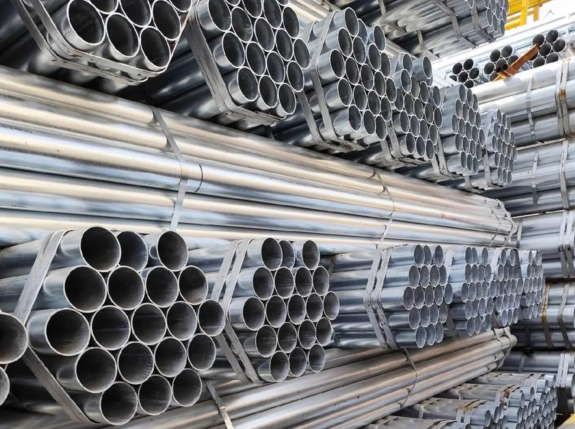GI pipe (galvanized iron pipe), is a type of metal pipe coated with zinc (a zinc layer) on the surface of ordinary steel pipe, primarily to prevent rust and extend its service life. It is widely used in many rural water supply projects to transport raw water and distribute treated water, where water availability is limited.
Key Features of GI Pipe:
- Corrosion Resistance: The zinc layer protects the steel pipe, reducing rust and ensuring durability in various environments.
- High-Temperature Resistance: Suitable for high-temperature media such as hot water and steam.
- Flexible Installation: Suitable for welding, threading, and flange connections, adapting to different project requirements.

- Durability: 10-30 years, capable of withstanding extreme conditions, ensuring a longer service life.
- Cost-Effectiveness: An affordable option for a variety of applications.
- Versatility: Suitable for residential, agricultural, and industrial use.
GI Pipe Specifications and Uses:
GI pipe is categorized into light, medium, and heavy gauges based on thickness and weight. Due to its durability, corrosion resistance, and affordability, it is widely used in a variety of applications.
Galvanized pipe is categorized by thickness and specific application:
- Light-Duty Galvanized Pipe (SCH 10 -SCH 40): Suitable for low-pressure fluid transport applications (e.g., water, gas).
- Medium-Duty Galvanized Pipe (
SCH 40 - SCH 80): Suitable for general plumbing and irrigation, general-purpose, building water supply, and fire protection piping.
- Heavy-Duty Galvanized Pipe (SCH 80 - SCH 160): Designed for high-pressure applications (e.g., drilling), such as high-pressure industrial piping and petrochemical applications.
Understanding these categories ensures you choose the right type of galvanized pipe for any project.
Industry Standards:
US:
ASTM A53 (hot-dip galvanized seamless and welded pipe)
Europe: EN 10240 (hot-dip galvanized pipe)
China: GB/T 3091-2015 (welded galvanized steel pipe)
Manufacturing Process:
The manufacturing process of GI pipe (galvanized iron pipe) primarily involves forming the steel pipe and galvanizing.
Steel Pipe Forming:
1) Seamless Steel Pipe (GI Seamless Pipe)
Bill heating (1200°C) → Piercing → Rolling → Sizing → Cooling → Straightening → Cutting
Features:
No welds, high pressure bearing capacity
Suitable for high-pressure, high-temperature environments (such as petroleum and chemical pipelines)
2) Welded Steel Pipe
High-frequency Electric Resistance Welding (
GI ERW Pipe):
Steel strip coiling → High-frequency current welding → Deburring → Sizing
Low cost, high efficiency, suitable for low-pressure fluid transportation.
Long-seam Submerged Arc Welding (LSAW):
Steel plate bending → Double-sided submerged arc welding → Expansion → Non-destructive testing
Used for large-diameter (≥Φ406mm) and
thick-walled pipes.
Galvanizing treatment:
(1) Hot-dip galvanizing
Process flow: Degreasing (alkaline washing) → Pickling (rust removal) → Coating (ammonium zinc chloride) → Hot-dip galvanizing (450℃) → Cooling → Passivation
Zinc layer thickness:
Standard thickness: 65-85μm
Common range: 45-120μm
Galvanizing amount: 320-600g/m²
Advantages:
Thick zinc layer (70-100μm), strong corrosion resistance
Strong bonding of zinc-iron alloy layer
(2) Electro-Galvanizing
Process flow: Electrolytic degreasing → Pickling → Electro-Galvanizing (zinc salt solution + current) → Passivation
Zinc Layer Thickness:
Standard Thickness: 5-15μm
Galvanizing Weight: 30-100g/m²
Features:
Thin zinc layer (5-15μm), smooth appearance
Low cost, but weaker corrosion resistance than
hot-dip galvanizing
Applications of GI Pipe:
- Piping Systems: GI pipes are widely used for water supply due to their corrosion resistance, such as urban water supply pipelines and fire protection systems.
- Irrigation and Agriculture: These pipes are ideal for water distribution in the agricultural sector, such as sprinkler systems and large-scale farm water supply pipelines.
- Construction Applications: GI pipes provide a sturdy framework for construction projects, such as structural supports, greenhouse frames, and guardrails.
- Industrial Uses: They reliably transport chemicals and gases, such as high-pressure fluids in the petroleum, chemical, and pharmaceutical industries.
- Drilling Systems: Their strength makes them suitable for high-pressure drilling applications.
You may also like: Difference Between GI Pipe and MS Pipe or Seamless Steel Pipe Pickling Process


